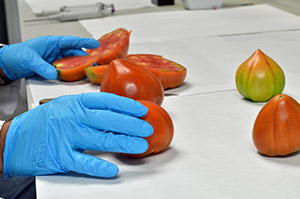Achieving tomatoes with higher quality, more flavour and heightened resistance to viruses and budding diseases. This is the goal of a European project coordinated from Valencia, specifically, from the Institute of Plant Molecular and Cellular Biology (IBMCP), mixed centre of the Polytechnic University of Valencia (UPV) and the Spanish National Research Council (CSIC). Called Harnesstom, it also sets out to improve the resistance of this vegetable to new conditions derived from climate change.
The project is being coordinated by Antonio Granell, research professor at the CSIC, and has a budget of €8.07 million, 7.04 of which have been provided by the Research and Innovation Framework Programme of the European Union (Horizon 2020), and the rest will be covered by the participating companies and the government of Taiwan.
Harnesstom (Harnessing the value of tomato genetic resources for now and the future) will be developed over the next four years. It will do so with the participation of institutions from seven countries, from small and medium-sized enterprises, to technology companies, farming companies, NGOs, farmer associations and several academic institutions.
“It is an initiative of great importance for a crop like the tomato. Firstly, because it will make it possible to offer the market solutions for this crop to better resist some of the new viruses that threaten it, such as the tomato brown rugose fruit virus (ToBRFV), as well as the challenges created by climate change. And secondly, because the project brings together all the necessary agents for the laboratory results to be transferred to the market: from us, the researchers, to producer associations, companies, NGOs, etc. All with a single goal: for the tomato that reaches our table to be better, in all aspects,” says Antonio Granell.
Fourth improvement programme
The tomato is a vegetable that is broadly grown and consumed, but with limited genetic diversity. Therefore, it is very vulnerable to budding diseases and climate change. “Fortunately, tomatoes are rich in genetic resources and enough information is available to overcome these difficulties. Harnesstom tries to prove that an increased use of the genetic resources is key for food safety and to achieve an end product with higher quality,” stresses Granell. Thus, and taking advantage of the great effort carried out recently as well as in several projects funded by the EU to connect phenotypes/genotypes, Harnesstom will compile, centralise and standardise this large amount of information so that, in a simple way, it may be used by different types of users.
Likewise, the project will carry out four pre-production programmes. The first will insert resistances to the main budding diseases. The second will seek to improve the tomato’s adaptation to climate change. The third programme will seek to improve the quality. And the fourth will try to increase the resilience of the traditional European tomato by way of participatory plant breeding.
Germplasm bank
Regarding the Polytechnic University of Valencia, as well as being coordinated by the IBMCP (UPV-CSIC), the University Institute for the Preservation and Improvement of Valencian Agrodiversity (COMAV) also takes part in the project. This institute of the UPV has a germplasm bank that includes one of the largest collections of genetic material of tomatoes and its wild relatives, which will be key to achieve varieties that are more resistant to the budding diseases that affect this crop.
Furthermore, the project intends to involve farmers, consumers, chefs who create trends and universities in activities for the design of innovative strategies that, ultimately, will lead to locally adapted cultivation materials.
A consortium of 22 institutions
As well as the UPV and CSIC, the project has five more partners in Spain: the Valencian Institute of Agricultural Research (IVIA), the Extremadura National Technological Agri-food Centre (CTAEX), the Cajamar Foundation of the Valencian Community, the Association of Producers and Sellers of the Tomata de Penjar from Alcalá de Xivert, and the Enza Zaden research centre.
The Harnesstom consortium also includes 15 more entities from Bulgaria, France, Italy, Israel, the Netherlands and Taiwan.
